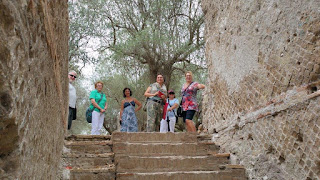Our Maltese tragedy was now becoming a Roman drama, as we still did not have a video camera. There was a fleeting moment when Garry thought he may stay behind in search of camera in Civitavecchia, but at the 11th hour decided against it.
Today we travelled All Round Italy with Valentino, Fabrizio’s younger brother. A definite family resemblance, but not one “Mama Mia” heard the entire day. He did a great job!
Basically, his job was to transport us to and from our destination, where Barbara took over in guiding us through the two famous Villas of Tivoli.
Villa Adriana (Hadrian’s Villa)
From the stories that Barbara regaled, it seems that Hadrian may have been a bit of a charmer. Well to everyone but his wife, but that may also have had something to do with his taste for young men!
Hadrian was adopted by the current Emperor Trajan, a cousin of his father. In those days succession was by choice and not birth right. Trajan was not a big fan, but his wife was, and it was she who campaigned for his cause. Trajan, even on his death bed was still not convinced, and it was Plotina, his wife, who devised a plot (is there a pun there) to convince everyone that with his dying breathe, Trajan named Hadrian as his Successor…. It did not go unnoticed that the only other person in the room (the emperor’s young favourite) died a few days later. Believe it not!!
Hadrian was said to have disliked the palace in Rome, so decided to build a place of his own. It is thought that the land at Tivoli was chosen mainly because his wife’s family owned it. The villa itself was part of much larger complex which is said to cover at least 250 acres and much of it is still unexcavated.
It contained over 30 buildings, including his and her houses. It seems it was out of sight out of mind, which suited both Hadrian and his wife. One that needs mentioning is the “Maritime Theatre”. Every complex this big need its own holiday house, so Hadrian built one. Think of a large round portico covered by a barrelled vault supported by pillars. A ring shape pool with a central island complete with house and draw bridge. Boasting a lounge, library, heated baths, bedrooms and art gallery - a real luxury getaway.
Call it fact or justification, but in those days, it was widely accepted and honoured that the older more knowledgeable men take the younger more impressionable boys under their wing to impart their wisdom. I think we have another name for it now! Anyway, Hadrian found Antoninius, a handsome young Greek of around 15 years of age. For around 5 years Hadrian imparted his wisdom on Antoninius; he was absolutely besotted with his young lover.
It is said that whilst travelling on the river Nile, Hadrian was given a prophesy of his impending death which could only be averted by the sacrifice of someone very close to him. Attempts to appease the gods were made, but the vision still remained. Antoninius knew there was only one solution and he took matters into his own hands. With nothing but a white shroud covering his taught Adonis body in an act of love, he jumped into the depths of the Nile and drowned.
It worked, and Hadrian lived. Hadrian was devastated and it had been noted, to quote “he wept like a woman”. To immortalize his favourite he founded the Egyptian city of Antinopolis, medals were created with an Antoninius effigy and statues erected of him all over the empire. There is a pool representing the Nile surrounded by statues, a memorial to his favourite at the villa.
Villa D’ Este
It’s a story not as romantic as Hadrian’s, and its only claim to fame for us is that it was commissioned to by Cardinal Ippolito II d’ Este, who happens to be Lucrecia Borgia’s son … Yes, we watched the entire series. Obviously as ostentatious as his grandfather, Pope Alexander VI, like a child with eyes bigger than his belly, he spent a lot of money building this grand villa. To save money a lot of the marble, statues and other antiques were taken from its neighbour, Hadrian’s Villa. The villa was never fully finished which is evident by the blank spaces left in the frescos that decorate the ceiling and walls. It is the gardens that are most impressive. Terraced down the mountain side, magnificent fountains, all gravity fed add to the richness of this villa.
The Fountain of the Organ is one of the most famous features of this garden is an organ that plays at certain times of the day, what makes this different, it is the water that plays the tune. No mechanics here, just the gravity fed water that drives the pipes to play. Barbara did try to explain, but i had to go to Mr Google to get the information. Water goes through a series of whirlpools, wish mix the water with air. Then dropped into a wind chamber where they separate again, the water turns a wheel, which rotates a cylinder that opens the valves of the 22 pipes, so the air passes through and makes the music… Simple!!
These gardens have been the inspiration for many gardens throughout Europe, with the most famous being the Tivoli Gardens in Denmark and the gardens of Peterhof Palace in St Petersburg.
<<...>> <<...>> <<...>> <<...>> <<...>> <<...>> <<...>> <<...>> <<...>> <<...>> <<...>> <<...>> <<...>> <<...>> <<...>> <<...>> <<...>> <<...>> <<...>> <<...>>





















No comments:
Post a Comment